


xxxxxAs we have seen, it was in 1192 (R1) that Yoritomo introduced the shogunate, a regime whereby hereditary feudal lords governed Japan, and the emperor became a mere figurehead. The most powerful dynasty was the Tokugawa family, in power from 1602. Under their strong rule Japan had long periods of peace and prosperity, but with the coming of the “barbarians” -
THE SHOGUNATE ENDS WITH THE RETURN OF IMPERIAL POWER 1868 (Vb)
Acknowledgements
Yoritomo: copy of 1179 original hanging scroll, attributed to the Japanese painter Fujiwara No Takanobu (1142-
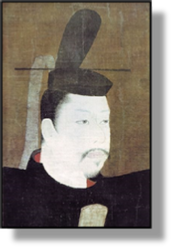 xxxxxAs we have seen, it was in 1192 (R1) that Minamoto Yoritomo (illustrated), having gained a decisive victory over the rival Taira family, established a new power-
xxxxxAs we have seen, it was in 1192 (R1) that Minamoto Yoritomo (illustrated), having gained a decisive victory over the rival Taira family, established a new power-
xxxxxThe Tokugawa shogunate, with its headquarters at Edo (today’s Tokyo), by its strict class hierarchy and its military-
xxxxxAt first Europeans were welcomed, but this quickly changed, and by 1650 the vast majority had been killed or expelled. But this policy of isolationism (known as Sakkoku) was brought to an abrupt end by the U.S. government in 1854 (Va). A naval squadron under the command of Commodore Matthew Perry virtually forced the shogunate to accept the terms of the Treaty of Kanagawa. As we have seen, this opened several ports for trade, and soon a number of European nations had claimed similar trading rights. The agreements they reached -
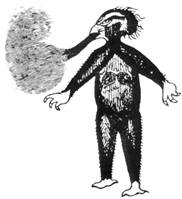 xxxxxThis influx of foreigners provided the catalyst for change in Japan. Already there was growing opposition to the Tokugawa shogunate. Taxes on the peasantry were set at a fixed amount, regardless of inflation, and this meant that the income of the major Samurai landowners, the daimyo, was being increasingly eroded. They offset their losses by cutting the rice stipend (their method of payment) and this brought growing discontentment among their retainers, the lower ranks of the Samurai, many of whom, by now, were bureaucrats rather than full-
xxxxxThis influx of foreigners provided the catalyst for change in Japan. Already there was growing opposition to the Tokugawa shogunate. Taxes on the peasantry were set at a fixed amount, regardless of inflation, and this meant that the income of the major Samurai landowners, the daimyo, was being increasingly eroded. They offset their losses by cutting the rice stipend (their method of payment) and this brought growing discontentment among their retainers, the lower ranks of the Samurai, many of whom, by now, were bureaucrats rather than full-
xxxxxThe slippery slope to civil war and the overthrow of the shogunate began in the early 1860s when opposition to the invading “foreign devil” turned into direct action. The majority of the daimyo and many of the middle and lower ranks of the samurai took up the slogan Sonno joi (“revere the emperor, repel the foreigner”), and there was an increasing number of attacks upon Europeans. The response was predictable. In 1862, following the murder of a British subject, the British bombarded the city of Kagoshima, and the following year, when the leader of the militant Choshu ordered an attack upon foreign ships in the Shimonoseki Strait, a combined western fleet attacked the clan’s coastal fortifications and imposed a heavy fine. But these attacks proved a turning point. In 1866 the Choshu and Satsuma clans joined forces with the declared aim of restoring imperial power, and they were reinforced later by the support of the Tosa and Hizen domains. At the same time, however, the shogun began modernising his army and navy with European help. The French in particular played a large part in advising on the use of weaponry and military tactics.
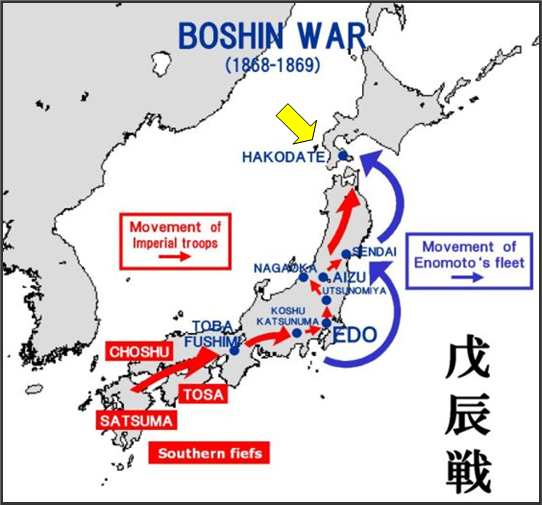 xxxxxThexinevitable clash came in 1868 with the outbreak of the Boshin War (meaning “War of the Year of the Dragon”). It did not prove much of a contest. The shogun, Yoshinobu, seized the initiative by launching a campaign to seize the imperial court at Kyoto, but his army was routed at a battle outside the city. The imperial forces, on the other hand, although outnumbered three to one, advanced northwards and, capturing Edo without a fight, forced the surrender of Yoshinobu (1837-
xxxxxThexinevitable clash came in 1868 with the outbreak of the Boshin War (meaning “War of the Year of the Dragon”). It did not prove much of a contest. The shogun, Yoshinobu, seized the initiative by launching a campaign to seize the imperial court at Kyoto, but his army was routed at a battle outside the city. The imperial forces, on the other hand, although outnumbered three to one, advanced northwards and, capturing Edo without a fight, forced the surrender of Yoshinobu (1837-
xxxxxThexMeiji Restoration was to bring big changes in Japan, most of them for the better. Once in power, the young emperor and his advisors abandoned their opposition to foreign influence within Japan -
xxxxxAnd with this new found strength was to go a policy of expansion. As we shall see, the defeat of China in the Sino-
xxxxxDue in large measure to the enlightened statesmanship of Saigo Takamori, a prominent leader in the new imperial government, those samurai who had fought on behalf of the shogun were shown a surprising degree of clemency. When the feudal system was abolished and universal conscription was introduced in 1872, they were pensioned off, and many were given posts of authority within the new regime. However, there were those samurai who resented losing their role and livelihood and took up arms in protest.
xxxxx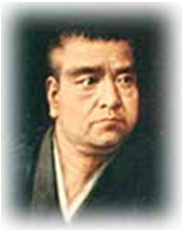 The biggest revolt, and literally the last uprising of the samurai in Japan, was that known as the Satsuma Rebellion in 1877-
The biggest revolt, and literally the last uprising of the samurai in Japan, was that known as the Satsuma Rebellion in 1877-
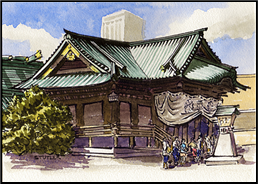
xxxxxIncidentally, the name “shogun” meaning a military dictator comes from the term seii tai shogun, translated as “great barbarian-
xxxxx…… The Yasukuni Shrine (meaning “Pacifying the Nation”) was constructed in Tokyo in June 1869 to commemorate those who died in the Boshin War, estimated at 3,500. It later became the principal national shrine in remembrance of Japan’s war dead.
Including:
The Boshin War and
The Satsuma Rebellion

Vb-


